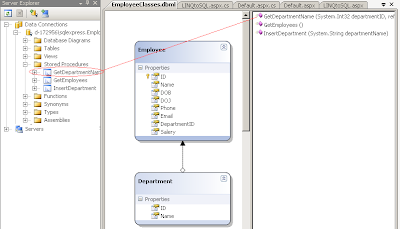LINQ to
SQL - call stored procedure with OUTPUT parameters
Once
the DataContext is in place we can go ahead and use it to process data from the
mapped database.
Assume that we have the following StoredProcedure [GetDepartmentName], in the database
CREATE PROCEDURE
[dbo].[GetDepartmentName]
@DepartmentID int,
@DepartmentName varchar(50) output
AS
BEGIN
SELECT
@DepartmentName = Name
From Department
WHERE
ID = @DepartmentID
END
Before using LINQ-to-SQL to
call the StoredProcedure we need to add the StoredProcedure to the right side
panel of the DataContext (.dbml) file.
Open the server Explorer and
drag the procedure to the right side panel of the .dbml file, your panel should
look as follows.
Once this is done we are ready to call the StoredProcedure from the code, the code is as follows.
EmployeeClassesDataContext dbContext = new EmployeeClassesDataContext();
string strDepartmentName = string.Empty;
dbContext.GetDepartmentName(1,
ref strDepartmentName);
Response.Write("Department Name: " +
strDepartmentName);
That’s it, we have called a
Stored procedure with an OUTPUT parameter using LINQ-to-SQL.



No comments:
Post a Comment